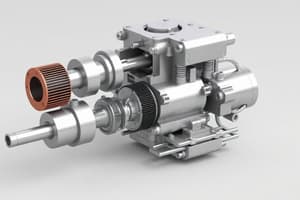Podcast
Questions and Answers
What is a child feature in parametric modelling?
What is a child feature in parametric modelling?
- A feature created based on another feature. (correct)
- A feature that exists independently.
- A feature that does not rely on any other feature.
- A feature that cannot change.
Reference geometry includes items like planes, axes, and points.
Reference geometry includes items like planes, axes, and points.
True (A)
What must the plane status be in order to create a reference plane?
What must the plane status be in order to create a reference plane?
Fully defined
A reference plane that creates a plane parallel to the selected plane is called __________.
A reference plane that creates a plane parallel to the selected plane is called __________.
Which of the following is NOT a type of reference used to create a reference plane?
Which of the following is NOT a type of reference used to create a reference plane?
Match the reference geometry options with their descriptions:
Match the reference geometry options with their descriptions:
You can create planes only in part documents, not in assembly documents.
You can create planes only in part documents, not in assembly documents.
Which toolbar option can you select to create a reference plane?
Which toolbar option can you select to create a reference plane?
What is the purpose of creating a mid plane?
What is the purpose of creating a mid plane?
You can create multiple reference points that are a specified distance apart on curves.
You can create multiple reference points that are a specified distance apart on curves.
What is the function of the Offset distance option when creating a plane?
What is the function of the Offset distance option when creating a plane?
The tangent option creates a plane that is tangent to _____ faces.
The tangent option creates a plane that is tangent to _____ faces.
Match the following reference plane types with their definitions:
Match the following reference plane types with their definitions:
Which of the following is NOT a method for creating reference geometry?
Which of the following is NOT a method for creating reference geometry?
Reference axes can only be used in a linear pattern.
Reference axes can only be used in a linear pattern.
What do the Second Reference and Third Reference sections do when creating a plane?
What do the Second Reference and Third Reference sections do when creating a plane?
What is the primary purpose of a coordinate system in SOLIDWORKS?
What is the primary purpose of a coordinate system in SOLIDWORKS?
A cylindrical face cannot be selected when creating a reference geometry.
A cylindrical face cannot be selected when creating a reference geometry.
What do you need to do to change the selections in the Coordinate System PropertyManager?
What do you need to do to change the selections in the Coordinate System PropertyManager?
To reverse the direction of an axis in the Coordinate System PropertyManager, click the __________ button.
To reverse the direction of an axis in the Coordinate System PropertyManager, click the __________ button.
Match the following selections with their descriptions in Reference Geometry:
Match the following selections with their descriptions in Reference Geometry:
Which of the following options allows you to select a vertex for the origin of a coordinate system?
Which of the following options allows you to select a vertex for the origin of a coordinate system?
You can use reference geometry only for part assemblies, not for individual parts.
You can use reference geometry only for part assemblies, not for individual parts.
What command is used to create a new coordinate system in SOLIDWORKS?
What command is used to create a new coordinate system in SOLIDWORKS?
What does the Isolate function allow you to do with components in an assembly?
What does the Isolate function allow you to do with components in an assembly?
You can only isolate one component at a time in an assembly.
You can only isolate one component at a time in an assembly.
What is the first step to create an exploded view in an assembly?
What is the first step to create an exploded view in an assembly?
To exit the isolated mode after working on components, click __________ on the Isolate pop-up toolbar.
To exit the isolated mode after working on components, click __________ on the Isolate pop-up toolbar.
Which of the following options is NOT available when modifying explode options?
Which of the following options is NOT available when modifying explode options?
Match the following exploded view options with their descriptions:
Match the following exploded view options with their descriptions:
What allows you to focus on selected components during assembly work?
What allows you to focus on selected components during assembly work?
Radial explode in assemblies allows components to diverge along a __________.
Radial explode in assemblies allows components to diverge along a __________.
What is the first step to create a radial exploded view in an assembly?
What is the first step to create a radial exploded view in an assembly?
Multiple exploded views can be created and stored within the same configuration.
Multiple exploded views can be created and stored within the same configuration.
Name the two types of appearances that can be applied to a model.
Name the two types of appearances that can be applied to a model.
To change an appearance, you can use the _________ PropertyManager to edit appearance properties.
To change an appearance, you can use the _________ PropertyManager to edit appearance properties.
Match the following methods of animation with their actions:
Match the following methods of animation with their actions:
Which of the following is a correct way to animate the explosion of an exploded view?
Which of the following is a correct way to animate the explosion of an exploded view?
Procedural appearances affect the physical properties of a model.
Procedural appearances affect the physical properties of a model.
What tool or tab can you use to assign an appearance to a model?
What tool or tab can you use to assign an appearance to a model?
What is the primary way to create a subassembly in a higher-level assembly?
What is the primary way to create a subassembly in a higher-level assembly?
A subassembly can be formed by selecting a group of components that are already present in the assembly.
A subassembly can be formed by selecting a group of components that are already present in the assembly.
What should you do when prompted about rebuilding the assembly after editing a component?
What should you do when prompted about rebuilding the assembly after editing a component?
When creating a subassembly, you can also insert a new, empty subassembly at any level of the assembly hierarchy while editing a __________ assembly.
When creating a subassembly, you can also insert a new, empty subassembly at any level of the assembly hierarchy while editing a __________ assembly.
Match the terms related to the rebuild process with their descriptions:
Match the terms related to the rebuild process with their descriptions:
Which of these is NOT a consequence of clicking 'Yes' when asked to rebuild the assembly?
Which of these is NOT a consequence of clicking 'Yes' when asked to rebuild the assembly?
The exploded view can help in visualizing the assembly process.
The exploded view can help in visualizing the assembly process.
What is a key benefit of using the PropertyManager in the assembly process?
What is a key benefit of using the PropertyManager in the assembly process?
Flashcards are hidden until you start studying
Study Notes
3D Part Modelling
- Building Blocks
- 3D Parts are the foundation of parametric modelling software.
- Individual shapes, called features, combine to form the part.
- Parent-Child Relationships
- Features rely on existing features for creation, e.g., a boss extrude is created on a base extrude.
- The original feature, in this case, the base extrude, is the parent.
- The new feature, the boss extrude, is the child.
- Child features are dependent on their parent features.
Reference Geometry
- Purpose
- Reference geometry outlines the shapes of surfaces and solids.
- It includes elements like planes, axes, coordinate systems, and points.
- It is used to define 3D features.
- Applications
- Planes are used in loft and sweep features.
- Axes are used for circular patterns.
Reference Planes
- Creation
- Can be created in parts or assemblies.
- Used for sketching, section views, and defining neutral planes.
- Steps
- Click "Plane" in the Reference Geometry toolbar.
- Select an entity for the "First Reference" – this determines the plane's orientation.
- Modify the plane with options like "Parallel," "Perpendicular," etc.
- Select "Second Reference" and "Third Reference" as needed to fully define the plane.
- The plane must be "Fully Defined" (message box notification) for successful creation.
- Plane Properties
- Options for the "First Reference" include:
- Coincident: Creates a plane passing through the selected reference.
- Parallel: Creates a plane parallel to the selected reference.
- Perpendicular: Creates a plane perpendicular to the selected reference.
- Project: Projects an entity onto a non-planar surface.
- Parallel to screen: Creates a plane parallel to the current view orientation.
- Tangent: Creates a plane tangent to various surfaces.
- At Angle: Creates a plane at an angle to a face.
- Offset Distance: Creates a plane parallel to a face, at a specific distance.
- Flip Normal: Reverses the plane's normal vector.
- Mid Plane: Creates a plane halfway between two planar faces.
- "Second Reference" and "Third Reference" have similar options.
- Options for the "First Reference" include:
- Examples
- Parallel: A plane parallel to an existing plane.
- Perpendicular: A plane perpendicular to a selected edge.
- Tangent: A plane tangent to a curved surface.
- At angle: A plane at a specific angle to a cylindrical face.
- Multiple offset: Creates multiple parallel planes at a specified distance.
- Mid plane: Creates a plane in the middle of two planar faces.
Reference Points
- Types
- Several reference point types are available for use as construction objects.
- Reference points can also be created at specified distances along curves.
- Creation
- Click "Point" on the Reference Geometry toolbar.
- Select the reference point type in the Property Manager.
- Select relevant entities for the reference point in the graphics area.
- Applications
- Reference points can be created at intersections of:
- An axis and a plane.
- An axis and a surface (planar or non-planar).
- Two axes.
- Reference points can be created at intersections of:
Reference Axes
- Purpose
- Axes are used for creating sketch geometry and circular patterns.
- Creation
- Click "Axis" on the Reference Geometry toolbar.
- Select the axis type in the Axis Property Manager.
- Select the required entities for that type.
- Ensure the "Reference Entities" correspond to your selections.
- Use View > Hide/Show > Axes to see the new axis.
- Axis Property Manager
- Used to create or edit axes.
- Options include:
- Reference Entities: Displays selected entities.
- One Line/Edge/Axis: For selecting a sketch line, edge, or axis.
- Two Planes: For selecting two planar faces.
- Two Points/Vertices: Selecting two vertices or points.
- Cylindrical/Conical Face: Selecting a cylindrical or conical face.
- Point and Face/Plane: Selecting a surface or plane and a point.
Coordinate Systems
- Purpose
- Define a coordinate system for a part or assembly.
- Useful for:
- Measure and Mass Properties tools.
- Exporting SOLIDWORKS documents to other formats.
- Applying assembly mates.
- Creation
- Click "Coordinate System" in the Reference Geometry toolbar.
- Use the Coordinate System Property Manager for customization.
- Right-click in the graphics area to clear selections.
- Use the "Reverse Axis Direction" button to change an axis's direction.
- Coordinate System Property Manager
- Used to create or edit coordinate systems.
- Options include:
- Origin: Selects the coordinate system's origin.
- X axis, Y axis, Z axis: Defines the direction of each axis using a reference.
- Reference options include points, edges, planes, etc.
Isolate
- Isolate functionality allows focusing on selected components by hiding, making transparent, or showing in wireframe the unselected ones.
- You can isolate components that share a mate by right-clicking the mate in the FeatureManager design tree
- You can change the isolated components' display state to hidden, wireframe, or transparent by using the Isolate pop-up toolbar.
- The transparency setting for editing a component within an assembly is different from the transparency used when Isolate is active.
- To isolate components:
- Select the components in the graphics area or the FeatureManager design tree.
- Click View > Display > Isolate, or right-click and click Isolate.
- To isolate components that share a mate, right-click the mate in the FeatureManager design tree and click Isolate.
- To exit Isolate, click Exit Isolate on the Isolate pop-up toolbar.
Creating Exploded Views in Assemblies
- Exploded Views are created by selecting and dragging parts, defining one or more steps.
- You can reverse the translation and rotation directions using the "Reverse Direction" option.
- You can specify translation distance with "Explode Distance" and rotation angle with "Rotation Angle".
- To create an exploded view:
- Click Exploded View (Assembly toolbar) or Insert > Exploded View.
- Select one or more components, and drag a translation or rotation handle to move them.
- Modify explode options.
- Click Done.
- Repeat steps 2-3 for other components.
- Click Done when completed.
Radial Explode
- You can explode components aligned radially/cylindrically about an axis in one step.
- You can explode radially by diverging along an axis.
- To radially explode components about an axis:
- Click Exploded View (Assembly toolbar) or Insert > Exploded View.
- Click Radial step under Add a Step in the Explode PropertyManager.
- Select components in Explode Step Components.
- Drag the handle in the graphics area and release.
- Click Done.
Exploding and Collapsing Exploded Views
- Exploded views are stored with the configuration in which they are created.
- Each configuration can have multiple exploded views.
- To explode and collapse an exploded view:
- Expand the configuration in the ConfigurationManager tab.
- Right-click the Exploded View feature and click Explode or Collapse.
- To animate the exploding and collapsing, right-click Exploded View and click Animate explode or Animate collapse.
Appearances
- Appearances define visual properties like color and texture, but do not affect physical properties which are defined by materials.
- In a part, you can add appearances to faces, features, bodies, and the part itself.
- In an assembly, you can add appearances to components.
Appearance Types
- Appearances can be procedural, wrapping around the reference, or textural, mapped to the reference.
- Procedural appearances are one color or a blended color applied to the entire reference, examples include Brushed Aluminum and White High Gloss Plastic.
- Textural appearances represent complex colorings of the appearance mapped to the reference, examples include Fire Brick and Polished Ash.
- The Mapping tab of the Appearances PropertyManager can be used to size, orient, and position the appearance on the model.
Changing an Appearance
- Assign an appearance by dragging it onto the model and selecting the target area in the Appearance Target palette.
- Use the Appearance PropertyManager to edit appearance properties.
- To assign an appearance:
- Click the Appearances, Scenes, and Decals tab in the Task Pane.
- Select a category in the Appearances folder.
- Drag an appearance onto the model and select the target area in the Appearance Target palette.
Mates
- Mates define the relationship between components in an assembly.
- Types of Mates:
- Standard Mate: defines relationships like concentric, tangent, flush, offset, and angle.
- Advanced Mate: defines relationships like coincident, parallel, perpendicular, and symmetrical.
- Universal Joint: allows one component's rotation to drive another component's rotation about its axis.
- To create a mate:
- Click Mate (Assembly toolbar) or Insert > Mate.
- Select the faces, edges, or vertices on the components to mate.
- In the PropertyManager, click under Standard Mate or Advanced Mate.
- Click Done.
Subassemblies
- A subassembly is an assembly that is part of another assembly.
- Subassemblies can be nested at multiple levels to reflect the design hierarchy.
- Ways to create a subassembly:
- Create a separate assembly document and insert it as a component in a higher-level assembly.
- Insert a new empty subassembly at any level of the assembly hierarchy while editing a top-level assembly.
- Form a subassembly by selecting a group of components already in the assembly.
Rebuild
- When switching back to the assembly window after editing a component in a separate window, the program will ask to rebuild the assembly.
- Rebuild incorporates the changes made to the component.
- Options for rebuilding:
- Yes: rebuilds the assembly.
- No: skips the rebuild of the assembly.
- Don't show again: suppresses the message.
- To rebuild the assembly:
- Click Rebuild (Standard toolbar) or Edit > Rebuild.
- Select Always Rebuild, Never Rebuild, or ask to rebuild based on the desired setting.
Studying That Suits You
Use AI to generate personalized quizzes and flashcards to suit your learning preferences.




